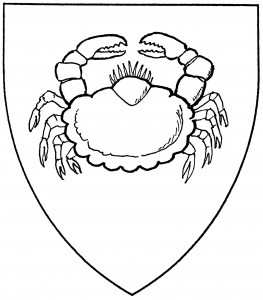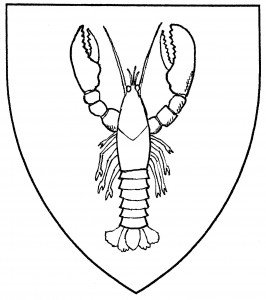The crab is a squat-bodied crustacean, with a reputation for irritability. Heraldically, it’s classed as a type of fish. It’s found in the arms of Bryger or Bridger, c.1470 [DBA2 338], and the canting arms (Italian granchio) of de Grangis d’Ast, mid-15th C. [Triv 166]. The crab was also the canting badge of Scrope, 1415, the crab being called a “scrap” in northern England [Hope2; also HCE xxviii].
Similar to the crab are the “lobster” and the “crayfish” (or “crevice”, from the French écrevisse): biologically distinct (living in saltwater and fresh water, respectively), they are indistinguishable for heraldic purposes. The lobster or crayfish is found as early as 1413, in the arms of Weiss [Conz.Const. cliiii], and in the canting arms (Italian gambero) of de Gambara, mid-15th C. [Triv 157]. It’s usually drawn with a longer body than the crab. However, there are instances in period armory of “crabs” (known to be such because of a cant) drawn with lobster-like tails; no difference is therefore granted between these crustaceans.
Also found in period armory is the “prawn”, similar to crayfish but without the claws; it’s found in the arms of Sea or Atsea, 1632 [Guillim2 241]. All of these crustaceans are tergiant by default, with their heads or claws to chief. See also scorpion.
Mór Ruadh bears: Gules, a crab Or.
Raymond Crus Hummer bears: Argent, a lobster gules.
Eckhardt zu Westfilde bears: Gules, two crayfish and on a base Or, a compass star gules, in chief a label of five points overall Or.
Jean Oste de Murat bears: Azure, a chevron argent between two prawns haurient respectant and a fleur-de-kys Or.

